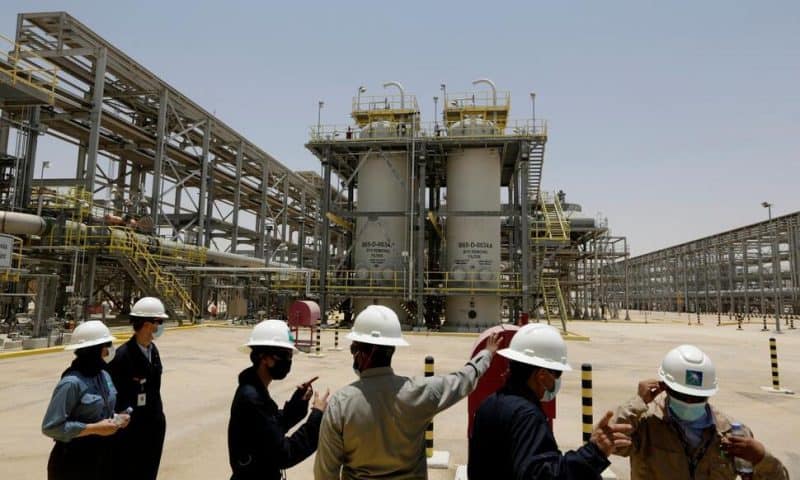Saudi oil company Aramco’s half-year profits peaked just shy of $88 billion as oil prices remain high globally.
DUBAI, United Arab Emirates — Saudi energy company Aramco said Sunday its profits jumped 90% in the second quarter compared to the same time last year, helping its half-year earnings reach nearly $88 billion. The increase is a boon for the kingdom and the crown prince’s spending power as people around the world pay higher gas prices at the pump while energy companies rake in top earnings.
Major oil companies had a strong quarter with Exxon Mobil booking an unprecedented $17.85 billion profit while Chevron made a record $11.62 billion. The U.K.’s Shell shattered its own profit record.
Aramco’s net profits were helped by second-quarter earnings ending in June that hit $48.4 billion — a figure higher than all of the first six months of 2021, when profits reached just $47 billion. It sets a new quarterly earnings record for Aramco since it first floated around 5% of the company on the Saudi stock market in late 2019.
Its earnings for just this past quarter are almost what Aramco’s full-year profits were in 2020, when demand for oil crashed during pandemic lockdowns. Its half-year earnings of $87.9 billion put Aramco on track to far surpass the full-year earnings of 2019, prior to the pandemic, when profits hit $88 billion.
The company credited the jump to higher crude oil prices and volumes sold, as well as higher refining margins. Saudi Arabia’s vast oil reserves are among the cheapest to produce in the world.
Aramco’s finances are crucial to the kingdom’s stability; when its margins are high, Saudi Arabia’s economic growth reflects that. As countries around the world grapple with inflation and recession, the International Monetary Fund projects the Saudi economy will grow by more than 7.6% this year, the highest globally.
Despite years of efforts by Crown Prince Mohammed bin Salman to diversify the economy, and some success in increasing non-oil revenue, Saudi Arabia continues to rely heavily on crude exports that pay for public sector salaries, generous benefits to citizens and defense spending. Aramco’s earnings also help the prince carry out his Vision 2030 infrastructure goals.
The company will pay a dividend of $18.8 billion for the second quarter to shareholders, as it has promised to do since its debut on the stock market. The higher profits bode well for the Saudi government, which is the main shareholder of Aramco.
Aramco is seen as the key to overhauling the Saudi economy. Its proceeds from the IPO were transferred to the country’s sovereign wealth fund to invest in projects to spur new sectors and generate new jobs for Saudi youth.
Brent crude has been trading at around $100 a barrel, even as OPEC, led by Saudi Arabia, and non-OPEC producers, led by Russia, have been steadily increasing production levels that had been cut during the height of the pandemic. The price of oil rose sharply after Russia invaded Ukraine in February. Prices have dipped below the $100 mark in past weeks amid slowed-down economic growth in China and the U.S.
Aramco President CEO Amin Nasser said he expects oil demand to continue to grow for the rest of the decade, despite current downward economic pressures. OPEC has said it expects world oil demand to rise by around 3 million barrels per day this year with total oil demand to average 100 million barrels a day.
Nasser said Aramco’s financial results so far this year reflect this increased demand for oil, even as countries around the world, including Saudi Arabia, pledge to cut their carbon emissions to avert catastrophic global warming levels.
“The world is calling out for affordable, reliable energy and we are answering that call,” he said, urging greater investments in oil and gas.
“At a time when the world is worrying about energy security, you are investing in the future of our business. Our customers know that whatever happens, Aramco will always deliver,” Nasser said in a short video released with the financial results.
Saudi Arabia is currently producing around 10.5 million barrels per day, with much of that exported to Asia and its largest customer, China. The crown prince has said the kingdom’s maximum production capacity is 13 million barrels per day. Aramco says it is working to one day reach that ceiling.
Aramco produces all of Saudi Arabia’s oil and gas with its production limits dictated by the energy ministry.

